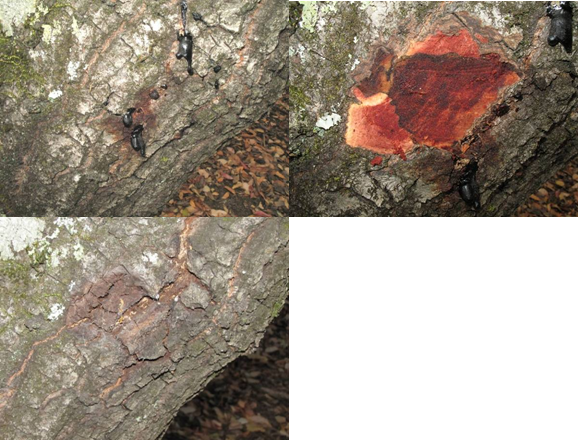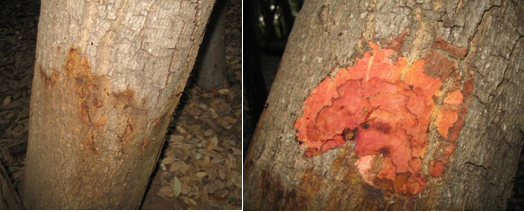
One of the most diagnostic symptoms of SOD is that new and older active cankers commonly bleed a dark, thick, sticky fluid (fig. 1-9). The fluid, which ranges from dark reddish brown to nearly black, oozes from the intact surface of infected bark tissue. The bleeding produced by SOD cankers is nearly odorless, but secondary organisms that invade the cankers can give rise to alcoholic or fermented odors. The fluid that oozes from cankers may dry and harden over the summer. Rainfall can dissolve the ooze, spreading it out, giving the canker and the area below it a “coffee-stained” appearance (fig. 1-10).

Figure 1-9—Bleeding Phytophthora ramorum canker on coast live oak; outer bark has been sliced away in right image to reveal the canker, which has an irregular dark border. This canker failed to expand and became inactive, as shown in bottom photo taken four years later.

Figure 1-10—Phytophthora ramorum canker on tanoak; in right image outer bark has been sliced away to show the irregular shaped canker in the inner bark.
The amount of bleeding produced can range from small droplets to copious amounts. Initially, small cankers may bleed from a single spot, but most large cankers will bleed from multiple areas. Visible bleeding may develop within 6 months of infection or may not develop for 2 years or more. Different host species and individuals within host species show varying amounts of bleeding. Coast live oak, Shreve oak, and California black oak typically develop extensive bleeding. Tanoak cankers sometimes do not bleed, especially in small diameter (<20 cm) stems. Cankers in canyon live oak usually show little or no visible bleeding.
When the outer bark is chipped away, P. ramorum cankers appear as brownish discolored lesions in the bark. Cankers typically have a distinct edge, often delimited by a dark line (fig. 1-9, 1-10). P. ramorum cankers are usually widest near the outer bark surface. Especially for small cankers, the apparent canker area decreases when more of the outer tissues are cut away.
Bleeding cankers caused by P. ramorum are visually indistinguishable from cankers caused by P. nemorosa and P. pseudosyringae. P. nemorosa primarily affects tanoaks whereas P. pseudosyringae is more commonly found on oaks. Both of these species appear to be less aggressive than P. ramorum, which is the only one of these species associated with extensive tree mortality (Wickland and others 2008). These and other agents that may cause bleeding are summarized in table 1-7.
Table 1-7—Common agents other than Phytophthora ramorum that may cause bleeding on oak trunks
| Agent | Disease / condition | How to distinguish from SOD cankers |
|---|---|---|
| Phytophthora nemorosa, P. pseudosyringae | Bole cankers | Cankers and bleeding identical to SOD cankers, but generally less widespread. Diagnostic tests (culturing or DNA-based) are required to differentiate from SOD. |
| Phytophthora cinnamomi, other soil Phytophthora species | Root and crown rot | Cankers and bleeding identical to SOD cankers, but normally very low on trunk and extending below ground, associated with root decay. More common in irrigated landscapes or in areas with high soil moisture. |
| Armillaria mellea (oak root fungus) and other Armillaria species | Root rot and wood decay in lower trunk | Bleeding may be similar but is usually very low on trunk. Affected areas have sapwood decay with white fanlike layers of fungal tissue (mycelium) between bark and wood and a mushroom odor. Decay originates in roots or root crown. |
| Inonotus andersonii, I. dryophilus, other fungi | Canker rot, wood decay | Ooze is dark but usually thinner. More likely to bleed extensively from one or few spots, often associated with wounds or cavities. Wood decay is commonly found beneath the bleeding area. Cankers are often quite small near the bark surface but become wider as they extend into the inner bark and wood. |
| Bacteria and associated microorganisms | Wetwood, alcoholic flux | Ooze is usually watery and not dark; may become slimy where it accumulates on the bark surface. Usually extensive bleeding from a single spot, often associated with wounds or cracks. Ooze may have a sour/rancid smell (wetwood) or may smell yeasty or alcoholic (alcoholic flux). When area is chipped, liquid may stream out under pressure. |
| Wood boring insects, including gold-spotted oak borer Agrilus auroguttatus | Insect boring damage | Ooze is typically thin and watery or sometimes foamy and light-colored. Bleeding comes from multiple small holes made by the insects, which may be localized or scattered across the trunk and branches. |